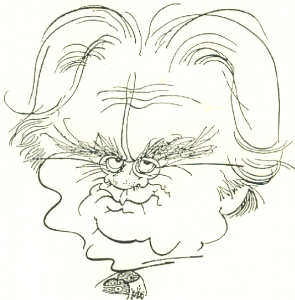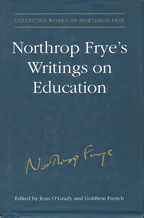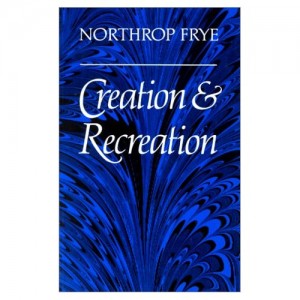In a letter to his future wife, Helen Kemp, dated 10 August, 1936, Frye gives an account of his journey from the Kemp family cottage on Gordon Bay to Montreal, and from Montreal to Moncton, to visit his parents for a month before leaving to begin his studies at Oxford. The trip to Montreal was “pretty bloody” with an open door behind and “an oxygen-and-cinders addict in front with an open window, so I caught a hay feverish cold which kept me sneezing like a threshing machine for a day or two.” Plus a fretful two-year-old “whose mother was working on a theory that she could stop her from crying by slapping her.” The trip from Montreal to Moncton was more pleasant.
From Bathurst down to Moncton I talked to the trainman, whose name is Cormier, a next-door neighbor of ours who is quite a friend of Dad. He probably has the best library in Moncton, and has been collecting and reading standard works on anthropology, comparative religion and evolutionary theory for twenty years. He undoubtedly knows far more about comparative religion than anyone in Emmanuel College. Very dogmatic and violently anti-clerical, full of Haeckel and Frazer type of materialism and rationalism. Somewhat narrowed by a profound conviction that all theological writers are either fools or deliberate liars, and quite surprised that I had read or even heard of any of the books he had read. The Acadian Frenchman is naturally a liberal free-thinker on good terms with the English, in contrast to the Quebec habitant, who is nationalist and obscurantist. The latter are gaining ascendancy through their superior spawning faculties, and are trying to foment racial quarrels here. Cormier is part of the vanguard of an agnostic tendency which I think will absorb eventually most of the urban population of French Canada. He made me feel ……. that he, a mere trainman, should ……. while I, who had been to University ……. Fill up the blanks with something pious and patronizing.
The month of August was a difficult month for Frye, as the letters back and forth between Frye and Kemp (collected in The Correspondence of Northrop Frye and Helen Kemp, 1932-1939, edited by Robert Denham) testify and as John Ayre’s brief summary (Northrop Frye: A Biography) also suggests. He was concerned about his lack of money, worried about his rapidly aging mother, and unhappy at the prospect of being separated from Helen for such a long time. Sometime just before August 20, in a letter from Helen that has gone missing and is not included in the Correspondence, he learned (but wanted not to believe) that she was pregnant, and in turmoil trying to decide what to do. But in the midst of these very tumultuous few weeks he did take time to visit and be entertained by his next-door neighbour, Cormier. There are two such occasions recorded in the Frye-Kemp Correspondence. In a letter dated August 20 (the same letter in which he asks Helen not to “jump to conclusions quite so quickly this time”) he writes:
I went over to see Cormier the other night. He takes a magazine called the Literary Guide, run by a group of people called Rationalists, a sort of anti-clerical cult. There’s a Rationalist club in Toronto which meets every Sunday. I was very much disappointed in it (he lent, or rather gave, me a few copies) – it’s a snuffling, canting, self-righteous, priggish little magazine, incredibly sectarian and narrow-minded. The magazine itself is one of those publisher’s rackets – its review section designed to advertise their books and knock other publishers’. However, I got a good bibliography from him, as he has some really good things, and some very rare and valuable books.
At the end of a long letter postmarked 29 August he writes:
I think I forgot to mention in my last letter that I saw Cormier again – he took me to see a pig-headed old fool of about 70 who reads his rationalist magazine and much the same books – deaf, and uses his deafness as an excuse for his pig-headedness. Rationalists seem to have only two ideas, that Jesus never lived and that the church has always persecuted. So I got Sun myths and public school history bellowed at me – or rather across me, as I took little part in the conversation – all evening long.
It’s clear that Frye was fascinated and repelled by his neighbour Cormier, with his collection of “very rare and valuable books,” his openness to new ideas, his anti-clericalism, and his narrow-mindedness. In the midst of Helen’s (and his) agony over her unwanted pregnancy, his worries about money, and the excitement of his imminent departure for England, he can’t stop talking about the trainman next door. I don’t know much about this Cormier, other than what Frye gives us in his letters. But I do know that his collection of books survived intact, handed down from generation to generation. In my capacity as a dealer in used and rare books I bought the entire collection from Cormier’s granddaughter, in September, 1994.
He penciled his name very neatly into all his books – Robert J. Cormier, or sometimes just R. J. Cormier. I don’t know if he continued living in the house near Frye’s, and I don’t know when he died. The books came into the possession of his son Wilfred J. Cormier, and when Wilfred died in 1992 his widow, Florence, kept possession. Two years later, in the spring or early summer of 1994, Jean Beers, Florence’s daughter, called me to come and look at the books and to make an offer. My offer seemed low to Jean Beers, but it was all that I could afford, and all that made sense to me, with my known clientele. I suggested she contact a book dealer in Halifax, who might offer more. I thought that was the end of it. I felt sick, because I had seen the books and recognized the treasure I had let slip through my hands.
But several months later Jean Beers called me again and asked if my offer still stood. I don’t know if she ever contacted the dealer in Halifax. I had the feeling she just wanted me to take them away. I made the cheque out to Florence Cormier, whom I don’t think I ever actually met. (Florence Cormier, as I discovered from a recent google search, died July 23, 2002, at age 82.)









